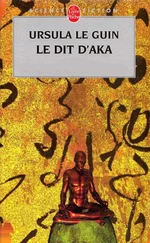It is possible that the ever-increasing vastness of the Building is a metaphor or illustration of precisely such a factual enormity. Or the Building’s size may be purely a result of its age. The oldest sections, far inside its outermost walls, show no indication that they were—or were not—seen as the beginning of something immense. They are exactly like the Aq children’s “houses” on a larger scale.
All the rest of the Building has been added on, year by year, to this modest beginning, in much the same style. After perhaps some centuries the builders began to add stories onto the flat roofs of the early Building, but have never gone above four stories, except for towers and pinnacles and the airy barrel domes that reach a height of perhaps sixty meters. The great bulk of the Building is no more than five to six meters high. Inevitably it has kept growing outwards laterally, by way of ells and wings and joining arcades and courtyards, until it covers so vast an area that from a distance it looks like a fantastic terrain, a low mountain landscape all in silvery green stone.
Although not dwarfish like the children’s structures, curiously enough the Building is not quite full scale, taking the average height of an Aq as measure. The ceilings are barely high enough to allow them to stand straight, and they must stoop to pass through the doors.
No part of the Building is ruined or in disrepair, though occasional earthquakes shake the Mediro plateau. Damaged areas are repaired annually, or “mined” for stone to rebuild with.
The work is fine, careful, sure, and delicate. No material is used but riqimite, mortised and tenoned like wood, or set in exquisitely fitted blocks and courses. The indoor surfaces are mostly finished satin smooth, the outer faces left in contrasting degrees of roughness and smoothness. There is no carving or ornamentation other than thin moldings or incised lines repeating and outlining the architectural shapes.
Windows are unglazed stone lattices or pierced stone sheets cut so thin as to be translucent. The repetitive rectangular designs of the latticework are elegantly proportioned; a ratio of three to two runs through many though not all of the Building’s rooms and apertures. Doors are thin stone slabs so well balanced and pivoted that they swing lightly and smoothly open and shut. There are no furnishings.
Empty rooms, empty corridors, miles of corridors, endlessly similar stairways, ramps, courtyards, roof terraces, delicate towers, vistas of roof beyond roof, tower beyond tower, dome beyond dome to the far distance; high rooms lighted by great lacework windows or only by the dim, greenish, mottled translucency of windowpanes of stone; corridors that lead to other corridors, other rooms, stairs, ramps, courtyards, corridors … Is it a maze, a labyrinth? Yes, inevitably; but is that what it was built to be?
Is it beautiful? Yes, in a way, wonderfully beautiful; but is that what it was built to be?
The Aq are a rational species. They have language. Answers to these questions must come from them.
The troubling thing is that they have many different answers, none of which seems quite satisfying to them or anyone else.
In this they resemble any reasonable being who does an unreasonable thing and justifies it with reasons. War, for example. My species has a great many good reasons for making war, though none of them is as good as the reason for not making war. Our most rational and scientific justifications—for instance, that we are an aggressive species—are perfectly circular: we make war because we make war. Our justifications for making a particular war (such as: our people must have more land and more wealth, or: our people must have more power, or: our people must obey our deity’s orders to crush the sacrilegious infidel) all come down to the same thing: we must make war because we must. We have no choice. We have no freedom. This argument is not ultimately satisfactory to the reasoning mind, which desires freedom.
In the same way, the efforts of the Aq to explain or justify their building and their Building all invoke a necessity which doesn’t seem all that necessary and use reasons which meet themselves coming around. We go stone faring because we have always done it. We go to Riqim because the best stone is there. The Building is on the Mediro because the ground’s good and there’s room for it there. The Building is a great undertaking, which our children can look forward to and our men and women can work together on. The stone faring brings people from all our villages together. We were only a poor scattered people in the old days, but now the Building shows that there is a great vision in us. —All these reasons make sense but don’t convince, don’t satisfy.
Perhaps the questions should be asked of those Aq who never have gone stone faring. They don’t question the stone faring. They speak of the stone farers as people doing something brave, difficult, worthy, perhaps sacred. So why have you never gone yourself? —Well, I never felt the need to. People who go, they have to go, they’re called to it.
What about the other people, the Daqo? What do they think about this immense structure, certainly the greatest enterprise and achievement on their world at this time? Very little, evidently. Even the sailors of the stone faring never go up onto the Mediro and know nothing about the Building except that it is there and is very large. Daqo of the northwest continent know it only as rumor, fable, travelers’ tales of the “Palace of the Mediro” on the Great South Continent. Some tales say the
King of the Aq lives there in unimaginable splendor; some say that it is a tower taller than the mountains, in which eyeless monsters dwell; others that it is a maze where the unwary traveler is lost in endless corridors foil of bones and ghosts; others that the winds blowing through it moan in huge chords like a vast aeolian harp, which can be heard for hundreds of miles; and so on. To the Daqo it is a legend, like their own legends of the ancient times when their mighty ancestors flew in the air and drank rivers dry and turned forests into stone and built towers taller than the sky, and so on. Fairy tales.
Now and then an Aq who has been stone faring will say something different about the Building. If asked about it, some of them reply: “It is for the Daqo.”
Indeed the Building is better proportioned to the short stature of the Daqo than to the tall Aq. The Daqo, if they ever went there, could walk through the corridors and doorways upright.
An old woman of Katas, who had been five times a stone farer, was the first who gave me that answer.
“The Building is for the Daqo?” I said, taken aback. “But why?”
“Because of the old days.”
“But they never go there.”
“It isn’t finished,” she said.
“A retribution?” I asked, puzzling at it. “A recompense?”
“They need it,” she said.
“The Daqo need it, but you don’t?”
“No,” the old woman said with a smile. “We build it. We don’t need it.”
THE PEOPLE OF GY look pretty much like people from our plane except that they have plumage, not hair. A fine, fuzzy down on the heads of infants becomes a soft, short coat of speckled dun on the fledglings, and with adolescence this grows out into a full head of feathers. Most men have ruffs at the back of the neck, shorter feathers all over the head, and tall, erectile crests. The head plumage of males is brown or black, barred and marked variously with bronze, red, green, and blue. Women’s plumes usually grow long, sometimes sweeping down the back almost to the floor, with soft, curling, trailing edges, like the tails of ostriches; the colors of the feathers of women are vivid—purple, scarlet, coral, turquoise, gold. Gyr men and women are downy in the pubic region and pit of the arm and often have short, fine plumage over the whole body. People with brightly colored body feathers are a cheerful sight when naked, but they are much troubled by lice and nits.
Читать дальше









